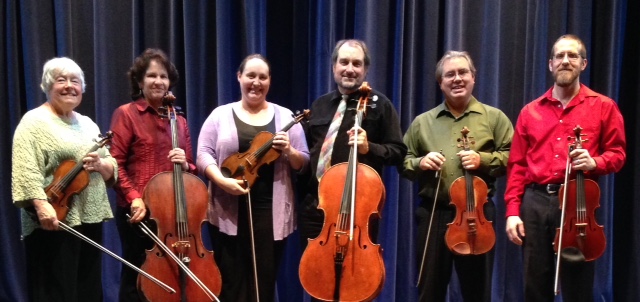|
Symphony
MONUMENTAL MAHLER 5TH IN SO CO PHIL'S SEASON ENDING CONCERT
by Terry McNeill
Sunday, April 14, 2024
Chamber
OAKMONT SEASON CLOSES WITH STRAUSS' PASSIONATE SONATA
by Terry McNeill
Thursday, April 11, 2024
Chamber
MORE GOLD THAN KORN AT ALEXANDER SQ CONCERT
by Terry McNeill
Sunday, April 7, 2024
Choral and Vocal
VIBRANT GOOD FRIDAY REQUIEM AT CHURCH OF THE ROSES
by Pamela Hicks Gailey
Friday, March 29, 2024
TWO OLD, TWO NEW AT THE SR SYMPHONY'S MARCH CONCERT IN WEILL
by Peter Lert
Saturday, March 23, 2024
Chamber
NOT A SEVENTH BUT A FIRST AT SPRING LAKE VILLAGE CONCERT
by Terry McNeill
Wednesday, March 20, 2024
THIRTY-THREE PLUS VARIATIONS AND AN OCEAN VIEW
by Terry McNeill
Saturday, March 16, 2024
Choral and Vocal
A ST. JOHN PASSION FOR THE AGES
by Abby Wasserman
Friday, March 8, 2024
Choral and Vocal
SPLENDID SCHUBERT SONGS IN SANET ALLEN RECITAL
by Terry McNeill
Saturday, March 2, 2024
Chamber
SHAW'S MICROFICTIONS HIGHLIGHTS MIRO QUARTET'S SEBASTOPOL CONCERT
by Peter Lert
Friday, March 1, 2024
|
 |
 Pajaro Ensemble March 13 in Lakeport |
STRING CHAMBER MUSIC IN LAKEPORT'S SOPER REESE THEATER
by Paula Mulligan
Sunday, March 13, 2016
As part of the Contemporary Chamber Music Series in March 13 in Lakeport’s Soper Reese Theater, the Pajaro Hill Ensemble performed a varied program that included Bach, Dvorak, J. Ives and Brahms.
Under the leadership of first violinist Tammie Dyer, whose exquisite tone always shone without dominating, the ensemble began with a portion of Bach’s A Musical Offering. The contrapuntal fugue in six parts was perfectly suited for the string sextet which includes violinist Marcia Lotter, cellists Joel Cohen and Cory Antipa, and violists Jeff Ives and David Hill. Their work together produced a sound that is greater than the sum of its parts. Clean attacks as each instrument entered into the fugue gave clarity and transparency to this complex piece and made it possible to hear each individual melodic line as well as the counter melodies.
For the second offering, a small group played Dvorak’s Op. 74 Terzetto for violinists Ms. Dyer and Ms. Lotter, and Mr. Ives. The first movement began with a restrained and thoughtful melody played with a velvety tone by all three performers. Later a Dumka-like peasant dance in Scherzo form implied the Czech folk music from which Dvorak derived many of his livelier themes. The work concluded with a stately theme with strong, sustained chords and a series of variations which include a lovely gypsy melody floating on arpeggios and a pulsating tremolo in the second violin and viola. As Mr. Ives remarked during his introduction of the work, it is “a little piece with a big heart.”
Mr. Ives’ Fantasy for String Sextet in a world premiere came next In 2007 much of the work was in a different form, and only recently it was rewritten for string sextet. Rather than the sometimes jarring dissonances of much contemporary music, Ives’ harmonies are more reminiscent of Ravel, gentle on the ears while remaining innovative, with the feel of an Impressionist painting. The title of Fantasy was chosen to describe the freedom of form which transitions easily between contrasting sections, and indeed the work remains cohesive through its various moods. In the composer’s description Fantasy begins “with a twelve bar theme passed between the violins over a bed of softly undulating chords in the lower strings.” As the piece moves through its development and the introduction of new melodic material, it builds to a climax which is followed by a darker mood led by the cellos, and a melancholy cello solo leads into a thinning of the voices and brings back the opening theme in a violin solo made memorable by Ms. Dyer’s heartbreakingly tender sound. The coda restores the lively feeling leading to a satisfying conclusion. Mr. Ives is a composer whose work deserves to be heard.
The program’s finale was the exquisite Brahms G Major Sextet No. 2, Op. 36. Beginning with a single viola playing a repeated two-note figure, a gorgeous melody emerged, first by the violins and then restated with passion by Mr. Cohen, whose mellow tone brings to mind dark chocolate. This melody recurs and is passed around among the instruments supported by rich Brahmsian harmonies.
In the second movement begins with two violins delicately playing over a whimsical pizzicato in the other strings, followed by unison passages played with great accuracy. A strongly rhythmic dance theme reminiscent of Hungarian dances develops in the middle and returns to the delicate beginning. Each movement had memorable passages, like the haunting duet with the first violin and first viola, ably supported by the second voices in each section. The ensemble playing was evident in the quiet and lovely third movement where each exposed line calls for exactness of intonation.
Playing in the last movement had the quality of a chase, a romp, always moving forward, sometimes as a fugue and interspersed with melodic sections once again taken over by the cello, and resolving into cascading runs
All the members of this group acquitted themselves nobly in this well-known work. The entire concert was a treat and it would be splendid if this configuration of musicians continue to work together.
|
